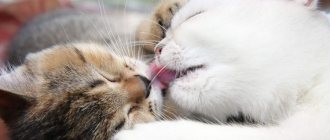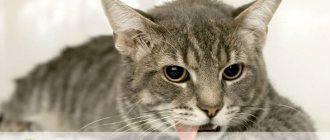Heated discussions regarding cat self-walking have divided cat owners into two camps. Some of them believe that a domestic cat should not leave the confines of an apartment or house, while others argue that forced confinement within four walls can hardly be considered caring for a pet. However, there are situations when the animal must be under the constant supervision of the owner (illness, injury, condition after surgery, estrus, etc.), and then it is necessary to re-educate the mustachioed-striped one, instilling in him an exclusively home regime.
“I, a cat, go wherever I please, and I walk on my own.”
Some purebred cats that have never left the apartment perceive the street as an alien environment and experience severe stress if they accidentally find themselves outside their native walls. Transporting such animals turns into a whole adventure, and training them to walk on a leash turns into a long training process.
However, most representatives of the cat tribe are freedom-loving and independent, therefore, having once tasted freedom, they will be eager to go outside again and again. It is noteworthy that the mustachioed striped animals seem to store within themselves all the experience of their wild ancestors and very quickly adapt to life in the natural environment. The street is attractive to cats for many reasons, including:
- Genetic memory of ancestors . This applies to the ubiquitous cats of the “noble” breed, whose parents and grandparents led a free life and took care of their own food and safety.
- Hunting instinct . A bloodthirsty predator slumbers in every murka, so the innate desire to ambush neighboring pigeons or the excitement of mouse hunting can provoke frequent unauthorized absences.
- Territorial instinct . A cat considers an apartment to be its territory, but individuals leaving the home expand their private boundaries and set up “control points” in the form of scent marks. Once in the wild, the first thing the cat does is walk around its property, examine the “messages” from its relatives and update its personal marks.
- Sexual instinct . The instinct of procreation forces sexually mature animals to persistently look for a mate and have offspring. Everyone knows the loud night serenades of March cats and brutal fights with opponents. Periods of sexual heat in cats (estrus) can also proceed very violently, accompanied by refusal to eat, characteristic poses and calling calls.
- Orienting instinct . Curiosity and the desire to discover new horizons are especially characteristic of young animals, so striving outside for a cat means fighting boredom and monotony.
- Social behavior . Despite the fact that many cats are loners, they are not alien to communication with their relatives and the corresponding manifestation of emotions.
- Need for physical activity . Domestic cats spend up to 18 hours a day in a sleepy and drowsy state, but exercise and exercise are important for them to maintain muscle tone and overall health. In freedom, this can include cross-country running, jumping, gymnastics and overcoming various obstacles.
- Energy discharge and activation of metabolism . Undoubtedly, cats with regular access to the street do not suffer from poor appetite, physical inactivity and obesity.
- Psychological hardening and personal experience . On the street, the animal is exposed to various stimuli, including negative and potentially dangerous ones, but gradually learns to choose the right course of behavior and resist stress factors. Undoubtedly, the nervous system of a street cat is much more stress-resistant than the pampered psyche of an animal that considers the apartment its whole world.
- Change of residence . It is known that cats are more attached to a place than to their owner. Therefore, moving may provoke a desire for the mustachioed one to return to his homeland.
- Lack of contact with the owner, bad attitude . Despite the relative independence of cats and the ability to distance themselves when communicating with people, they are very sensitive to negativity and may prefer the street to a home where they are not welcome.
Take your kitty for a walk
How to stop a cat from running away from home? If your pet really wants to go outside, then it would be a good idea to introduce her to the street . A walk together will help satisfy the cat's interest and will be great entertainment. True, you need to thoroughly prepare for going out, otherwise the acquaintance may be unsuccessful.
- You can only walk with a healthy kitty that has been vaccinated against major cat infections, including rabies.
- It is forbidden to walk with a cat during estrus.
- First you need to buy a harness from. A leash for cats is not the best solution because cats have very delicate necks.
- Then, the kitty needs to be accustomed to a harness . Dress her up and try walking around the house together. After several such walks at home, you can move on.
- Do not take your cat directly outside on its first walks. First, introduce her to the entrance . If your pet is afraid, you can carry her out in your arms.
- When the cat is ready to walk outside the entrance, choose a quiet place for a walk and the optimal time when there will be the least number of cars and passers-by .
- Take your cat out for walks only with a harness . At first, she may be alarmed by loud noises and oncoming people. If your cat gets scared, stop walking and take her home immediately.
Dangers of self-walking
Accustomed to going AWOL, the cat usually returns home, but the absence can last several days and is associated with various dangers and troubles.
A cat walking on its own can:
- die under the wheels of a car;
- wander far from home and get lost;
- become a victim of flayers;
- being maimed or killed by dogs;
- get injured in a fight with rival cats;
- contract an infection or parasites;
- eat poisoned bait or rodent;
- to climb a tree out of fear and not be able to get down.
The result of a female cat's street adventures is usually an unexpected litter that has to be disposed of. In addition to such surprises, the roaming cat increasingly moves away from the owner and becomes, in fact, a stray animal, coming home once every couple of days to eat and take a little nap.
General information
So, as we have already indicated above, cats belong to the category of very prolific animals. More precisely, small cats. This is not surprising, since the species tries to maintain its optimal numbers in this way. If you look at “orphan” animals, then without any surprise you can reveal that out of a dozen kittens born, barely two or three individuals survive to the age of one year . And this is in the relatively comfortable conditions of modern megacities, where homeless cats have no problems with food.
In more severe natural conditions, “debit and credit” may generally converge in a negative proportion. Predators, climate, and other unfavorable factors can lead to the death of not only the entire litter, but also the mother herself. All this leads to the fact that the cat’s body is programmed by nature for maximum productivity. It is for this reason that the cat begins to walk (or rather, can begin) almost immediately after giving birth.
But if in natural conditions such fertility is more than justified, then in domestic conditions it is not so much. Moreover, this leads to numerous problems, which we will write about below.
Ways to wean a cat off the street
If the owner has firmly decided to turn a freedom-loving animal into a purring pet, then he will have to radically change the pet’s behavioral habits and its psychology.
Undoubtedly, indoor confinement will at first be perceived as “house arrest,” and a cat accustomed to walking on its own will protest, get nervous, and persistently ask to be freed.
For the idea of “domestication” to be successful, first of all, additional measures are needed to correct the interior, namely:
- It is necessary to install strong mosquito nets or bars on the windows so that the mustachioed one cannot dive into the window or squeeze through the gap when the windows are open in ventilation mode. Having a cat within a closed balcony will brighten up the adaptation period, but if there is an open balcony, it is necessary to exclude the pet from access there.
- To reduce the cat’s desire to scratch the front or balcony door, jump on it and loudly lament about its plight, it is necessary to make the door an unpleasant and even frightening object. For these purposes, they use repellent sprays from pet stores, applying the contents of the container to the door leaf, laying out fresh citrus zest nearby, or simply stopping the cat’s decisive actions by spraying a stream of water from a spray bottle into its face, clapping their hands, or expressing their disapproval with a loud shout. If the cat knows how to open the door on its own by pressing the handle, then it is recommended to place a small light box with dry peas on top, and as soon as the tailed smart guy pulls the handle, the peas will begin to bombard from above without physically causing harm.
- To diversify the cat's leisure time, purchase various toys, a play complex with hammocks, hanging shelves, multi-level houses and teasers, as well as scratching posts of various configurations. So that the pet does not get bored and can realize its hunting instincts, the owner must allocate about an hour of time every day for active games and fun with the cat, training and practicing tricks. A splash of energy in the right direction and the development of good manners will prevent such unwanted manifestations of cat protest as torn curtains, scratched furniture and torn wallpaper.
- An “arrested” cat who is upset will need a secluded corner where he can calm down and fall asleep. Such a personal space can be a comfortable bed, a closed frame house or a soft “burrow-tunnel”. It is strictly forbidden to disturb an animal that has entered its den.
- In order to train to the toilet within an apartment, it is necessary to purchase a tray of a suitable size and wood filler that is as close as possible to natural litter. Felinologists recommend installing 2-3 trays in different places, giving the cat the opportunity to independently choose the most suitable place. The main rule is that the toilet area should not be located close to the cat’s dining room or sleeping area.
Is it possible to prevent postpartum sexual desire?
In principle, heat immediately after birth is not a very typical case, and we would recommend showing such a cat to a veterinarian. But estrus may well be triggered by irritants from the external environment. The main factor is the presence of a cat nearby. Sometimes even the company of a long-neutered and completely “incompetent” pet is enough. Thus, in cases where you have several pets of different sexes at home, the cat after giving birth must be isolated from them in a separate room.
In addition, try to minimize the effect of stress factors on your pet. Protect her from sharp and loud sounds and smells, and do not start renovations at home at least until the kittens begin to feed on their own. Otherwise, the cat’s body may “wedge” and she will decide that the cubs, being in “mortal danger,” are doomed anyway. And therefore she can leave them and start walking again.
Quality nutrition plays an important role. If the animal’s body receives all the nutrients, micro- and macroelements, then there will be no problems with the kittens’ nutrition . But in the opposite cases, everything is much worse. When a cat’s body “feels” that it is “not up to the task” of feeding kittens, a biological mechanism can come into play, the essence and results of which we have already written about several times above. So it is in your best interests to feed your newborn pet normally.










